Alfa Romeo 4C Spider 2016 Owner's Manual
Manufacturer: ALFA ROMEO, Model Year: 2016, Model line: 4C Spider, Model: Alfa Romeo 4C Spider 2016Pages: 371, PDF Size: 2.93 MB
Page 101 of 371
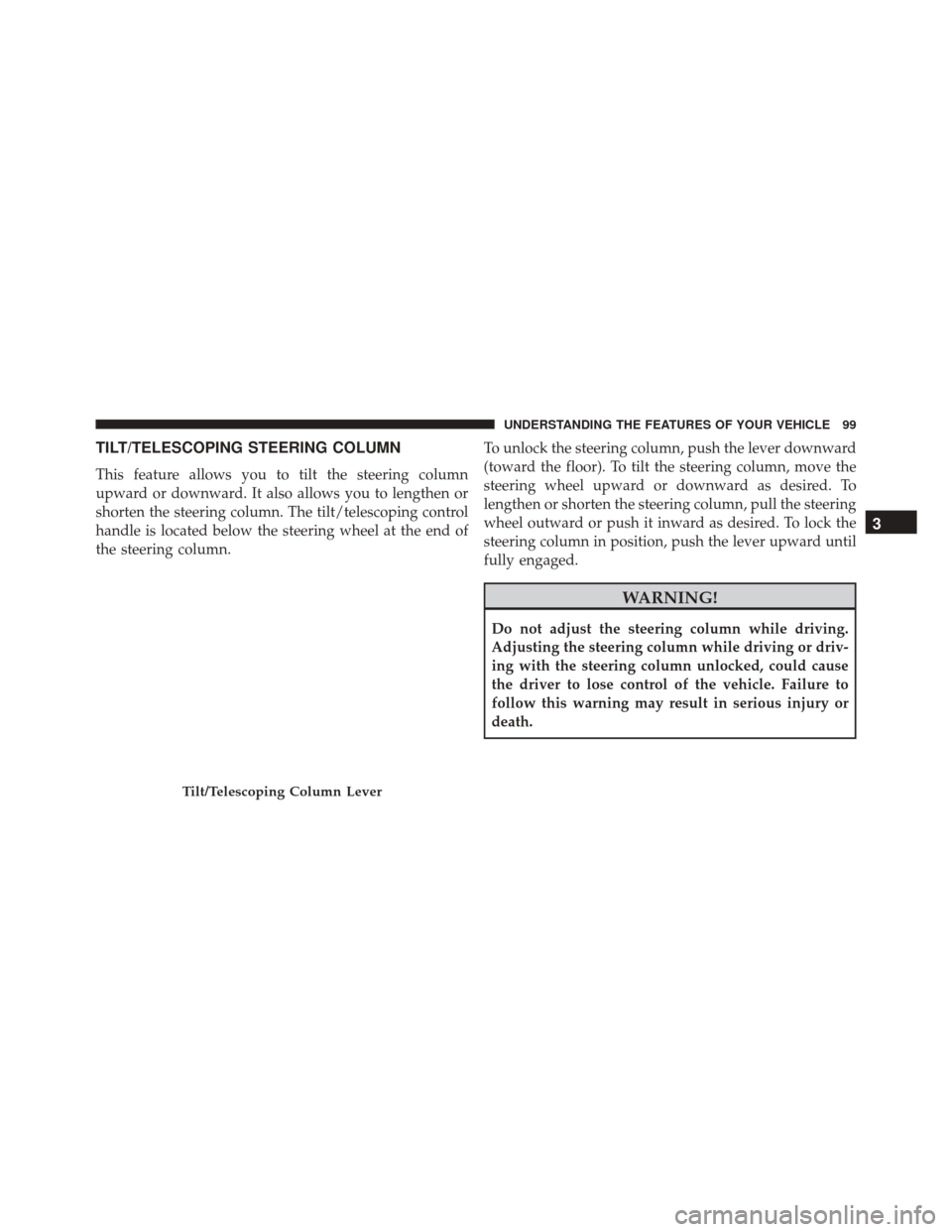
TILT/TELESCOPING STEERING COLUMN
This feature allows you to tilt the steering column
upward or downward. It also allows you to lengthen or
shorten the steering column. The tilt/telescoping control
handle is located below the steering wheel at the end of
the steering column.To unlock the steering column, push the lever downward
(toward the floor). To tilt the steering column, move the
steering wheel upward or downward as desired. To
lengthen or shorten the steering column, pull the steering
wheel outward or push it inward as desired. To lock the
steering column in position, push the lever upward until
fully engaged.
WARNING!
Do not adjust the steering column while driving.
Adjusting the steering column while driving or driv-
ing with the steering column unlocked, could cause
the driver to lose control of the vehicle. Failure to
follow this warning may result in serious injury or
death.
Tilt/Telescoping Column Lever
3
UNDERSTANDING THE FEATURES OF YOUR VEHICLE 99
Page 102 of 371
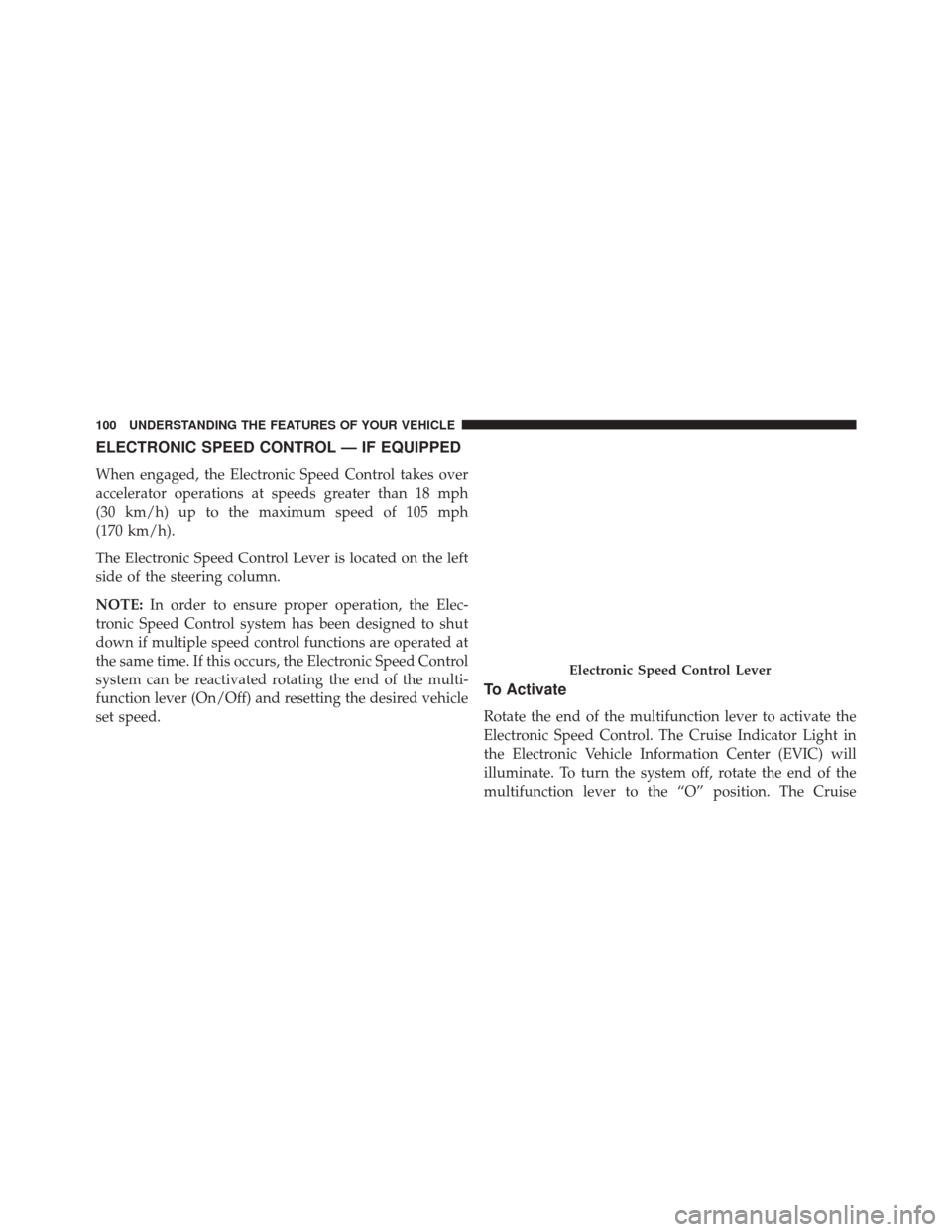
ELECTRONIC SPEED CONTROL — IF EQUIPPED
When engaged, the Electronic Speed Control takes over
accelerator operations at speeds greater than 18 mph
(30 km/h) up to the maximum speed of 105 mph
(170 km/h).
The Electronic Speed Control Lever is located on the left
side of the steering column.
NOTE:In order to ensure proper operation, the Elec-
tronic Speed Control system has been designed to shut
down if multiple speed control functions are operated at
the same time. If this occurs, the Electronic Speed Control
system can be reactivated rotating the end of the multi-
function lever (On/Off) and resetting the desired vehicle
set speed.
To Activate
Rotate the end of the multifunction lever to activate the
Electronic Speed Control. The Cruise Indicator Light in
the Electronic Vehicle Information Center (EVIC) will
illuminate. To turn the system off, rotate the end of the
multifunction lever to the “O” position. The Cruise
Electronic Speed Control Lever
100 UNDERSTANDING THE FEATURES OF YOUR VEHICLE
Page 103 of 371
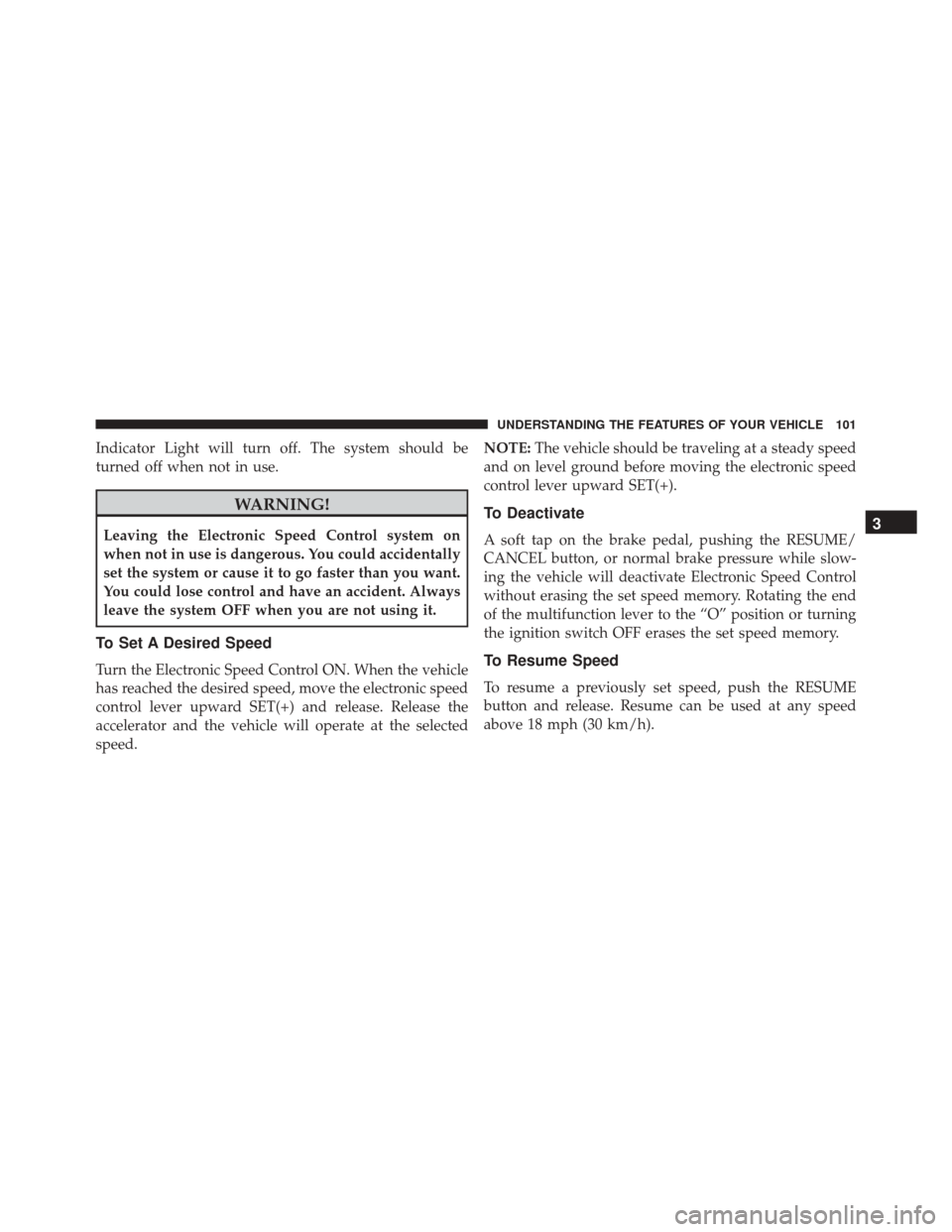
Indicator Light will turn off. The system should be
turned off when not in use.
WARNING!
Leaving the Electronic Speed Control system on
when not in use is dangerous. You could accidentally
set the system or cause it to go faster than you want.
You could lose control and have an accident. Always
leave the system OFF when you are not using it.
To Set A Desired Speed
Turn the Electronic Speed Control ON. When the vehicle
has reached the desired speed, move the electronic speed
control lever upward SET(+) and release. Release the
accelerator and the vehicle will operate at the selected
speed.NOTE:
The vehicle should be traveling at a steady speed
and on level ground before moving the electronic speed
control lever upward SET(+).
To Deactivate
A soft tap on the brake pedal, pushing the RESUME/
CANCEL button, or normal brake pressure while slow-
ing the vehicle will deactivate Electronic Speed Control
without erasing the set speed memory. Rotating the end
of the multifunction lever to the “O” position or turning
the ignition switch OFF erases the set speed memory.
To Resume Speed
To resume a previously set speed, push the RESUME
button and release. Resume can be used at any speed
above 18 mph (30 km/h).
3
UNDERSTANDING THE FEATURES OF YOUR VEHICLE 101
Page 104 of 371
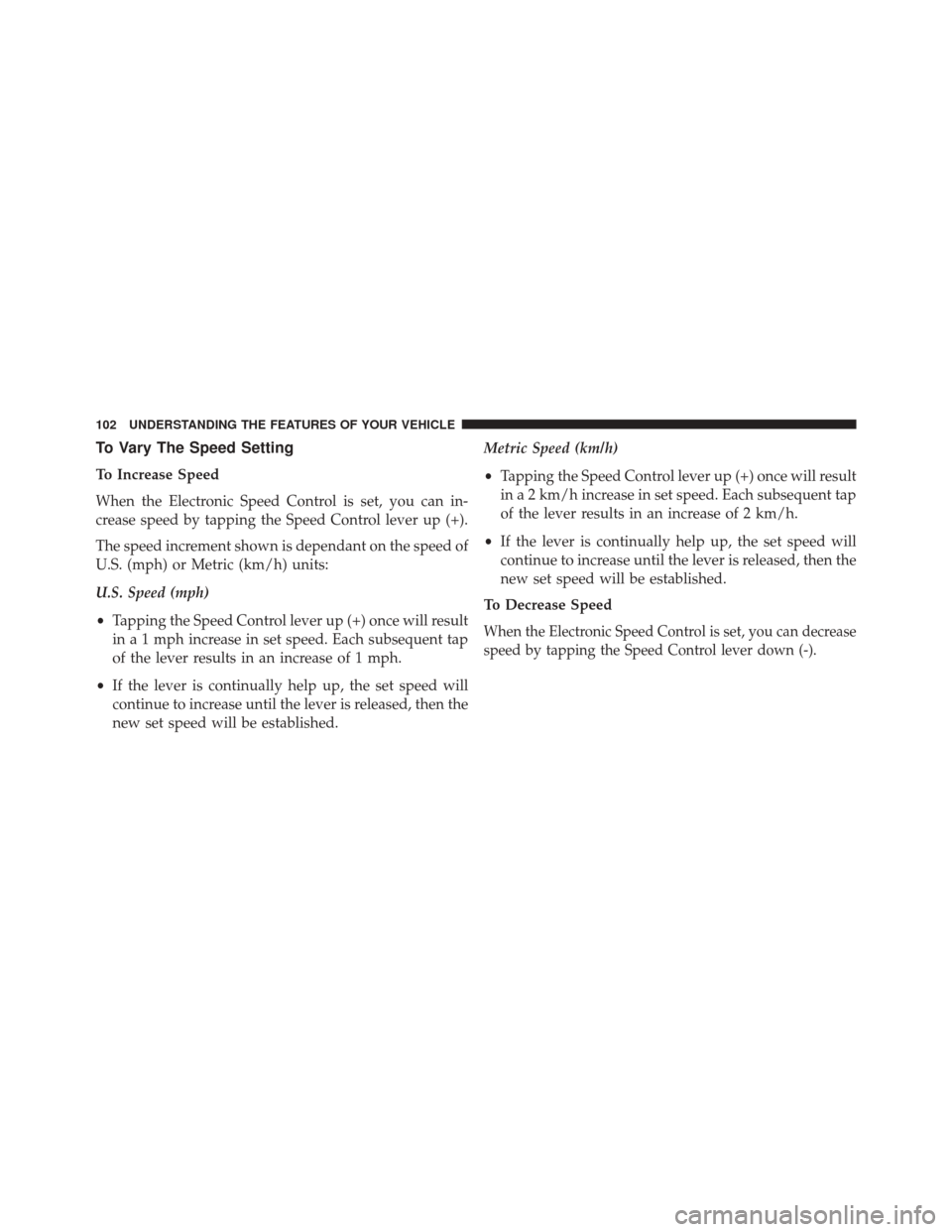
To Vary The Speed Setting
To Increase Speed
When the Electronic Speed Control is set, you can in-
crease speed by tapping the Speed Control lever up (+).
The speed increment shown is dependant on the speed of
U.S. (mph) or Metric (km/h) units:
U.S. Speed (mph)
•Tapping the Speed Control lever up (+) once will result
in a 1 mph increase in set speed. Each subsequent tap
of the lever results in an increase of 1 mph.
• If the lever is continually help up, the set speed will
continue to increase until the lever is released, then the
new set speed will be established. Metric Speed (km/h)
•
Tapping the Speed Control lever up (+) once will result
in a 2 km/h increase in set speed. Each subsequent tap
of the lever results in an increase of 2 km/h.
• If the lever is continually help up, the set speed will
continue to increase until the lever is released, then the
new set speed will be established.
To Decrease Speed
When the Electronic Speed Control is set, you can decrease
speed by tapping the Speed Control lever down (-).
102 UNDERSTANDING THE FEATURES OF YOUR VEHICLE
Page 105 of 371

The speed decrement shown is dependant on the speed
of U.S. (mph) or Metric (km/h) units:
U.S. Speed (mph)
•Tapping the Speed Control lever down (-) once will
result in a 1 mph decrease in set speed. Each subse-
quent tap of the lever results in a decrease of 1 mph.
• If the lever is continually held down, the set speed will
continue to decrease until the lever is released, then
the new set speed will be established. Metric Speed (km/h)
•
Tapping the Speed Control lever down (-) once will
result in a 2 km/h decrease in set speed. Each subse-
quent tap of the lever results in a decrease of 2 km/h.
• If the lever is continually held down, the set speed will
continue to decrease until the lever is released, then
the new set speed will be established.
To Accelerate For Passing
Press the accelerator as you would normally. When the
pedal is released, the vehicle will return to the set speed.
3
UNDERSTANDING THE FEATURES OF YOUR VEHICLE 103
Page 106 of 371
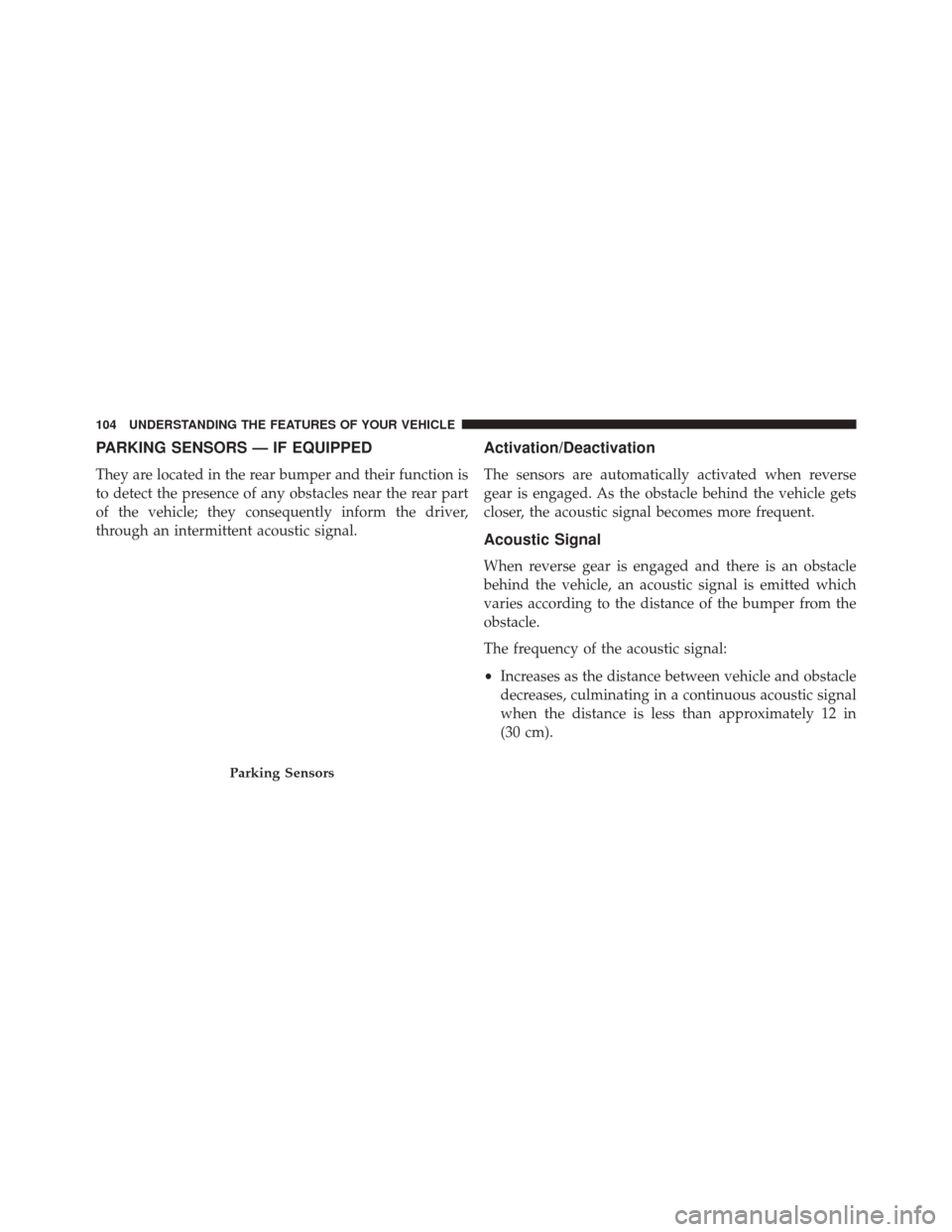
PARKING SENSORS — IF EQUIPPED
They are located in the rear bumper and their function is
to detect the presence of any obstacles near the rear part
of the vehicle; they consequently inform the driver,
through an intermittent acoustic signal.
Activation/Deactivation
The sensors are automatically activated when reverse
gear is engaged. As the obstacle behind the vehicle gets
closer, the acoustic signal becomes more frequent.
Acoustic Signal
When reverse gear is engaged and there is an obstacle
behind the vehicle, an acoustic signal is emitted which
varies according to the distance of the bumper from the
obstacle.
The frequency of the acoustic signal:
•Increases as the distance between vehicle and obstacle
decreases, culminating in a continuous acoustic signal
when the distance is less than approximately 12 in
(30 cm).
Parking Sensors
104 UNDERSTANDING THE FEATURES OF YOUR VEHICLE
Page 107 of 371
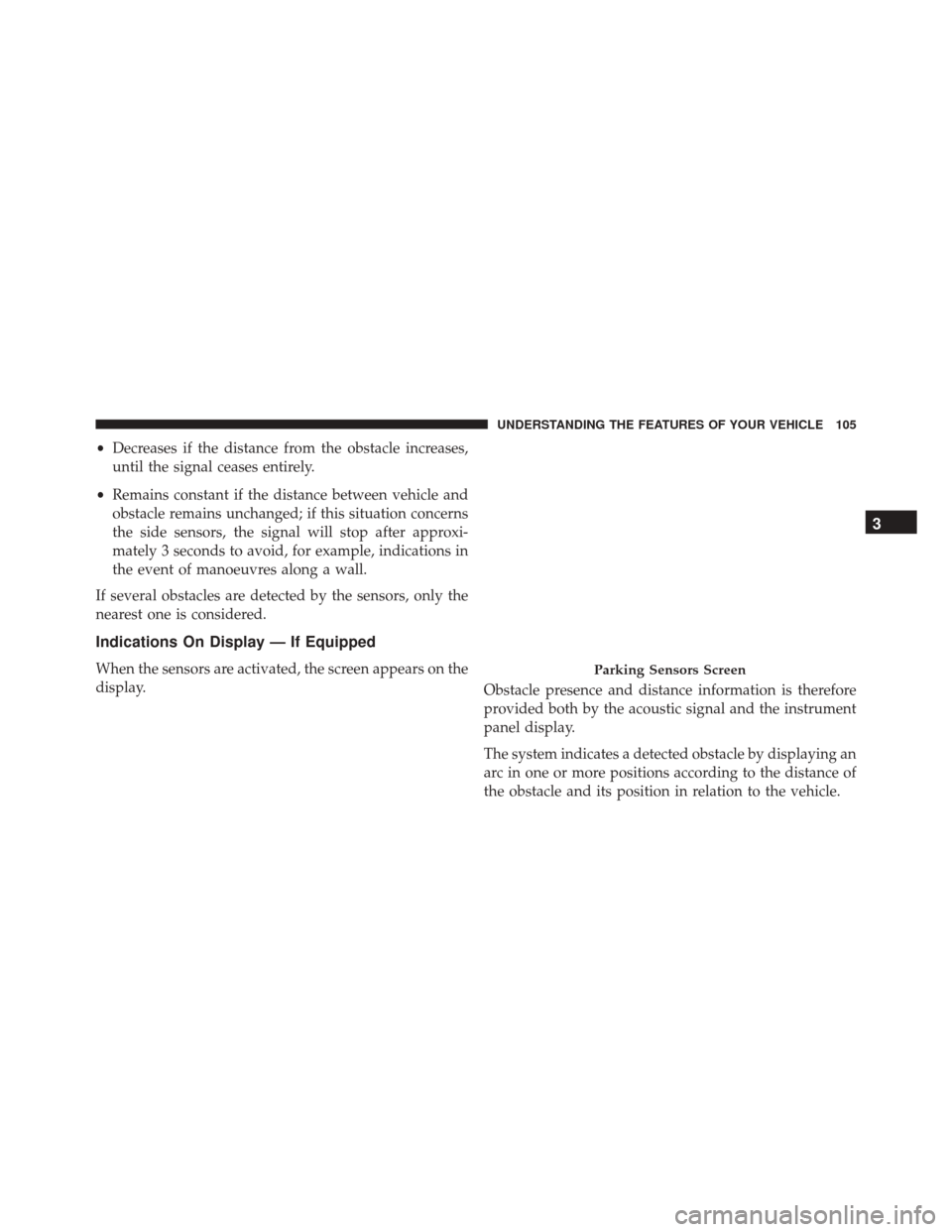
•Decreases if the distance from the obstacle increases,
until the signal ceases entirely.
• Remains constant if the distance between vehicle and
obstacle remains unchanged; if this situation concerns
the side sensors, the signal will stop after approxi-
mately 3 seconds to avoid, for example, indications in
the event of manoeuvres along a wall.
If several obstacles are detected by the sensors, only the
nearest one is considered.
Indications On Display — If Equipped
When the sensors are activated, the screen appears on the
display. Obstacle presence and distance information is therefore
provided both by the acoustic signal and the instrument
panel display.
The system indicates a detected obstacle by displaying an
arc in one or more positions according to the distance of
the obstacle and its position in relation to the vehicle.Parking Sensors Screen
3
UNDERSTANDING THE FEATURES OF YOUR VEHICLE 105
Page 108 of 371
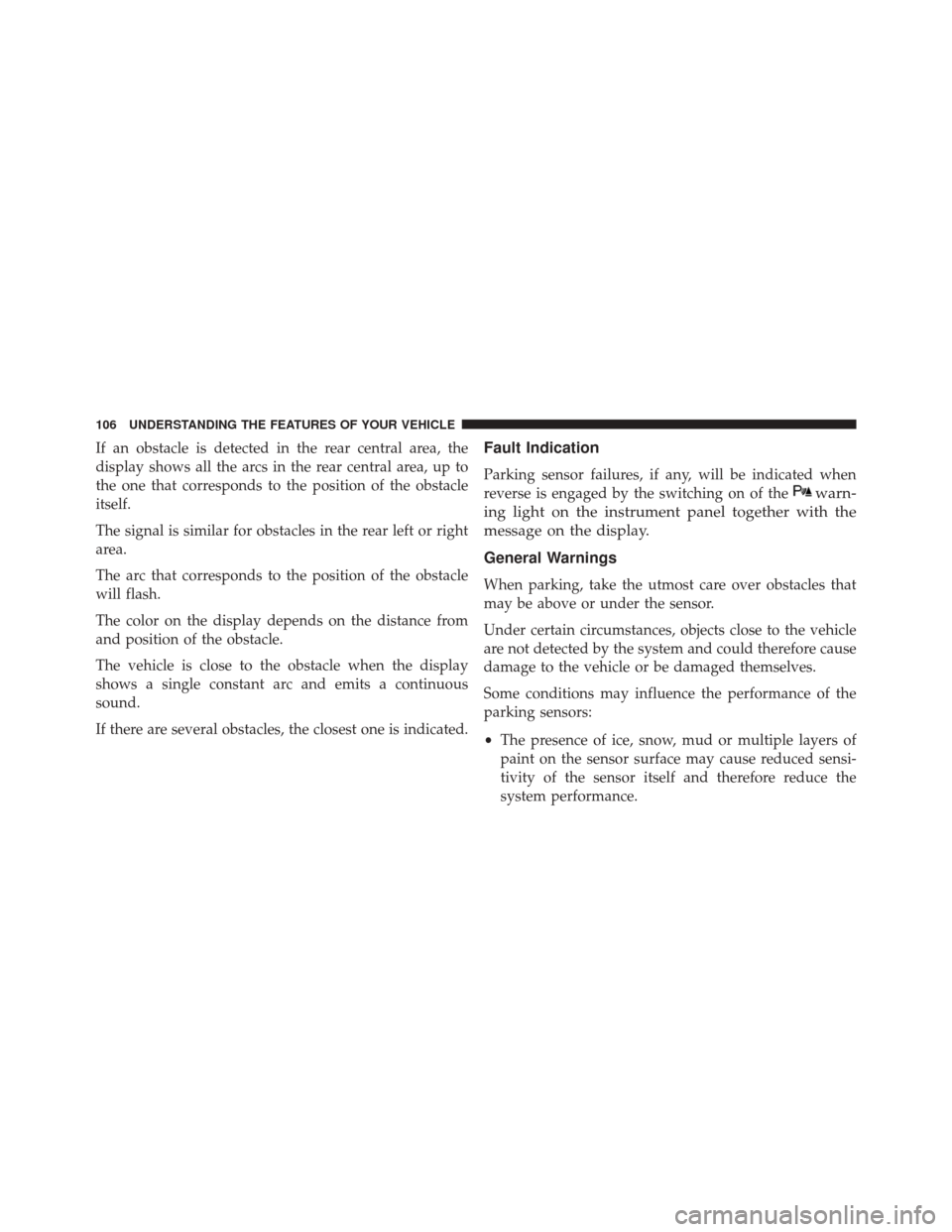
If an obstacle is detected in the rear central area, the
display shows all the arcs in the rear central area, up to
the one that corresponds to the position of the obstacle
itself.
The signal is similar for obstacles in the rear left or right
area.
The arc that corresponds to the position of the obstacle
will flash.
The color on the display depends on the distance from
and position of the obstacle.
The vehicle is close to the obstacle when the display
shows a single constant arc and emits a continuous
sound.
If there are several obstacles, the closest one is indicated.Fault Indication
Parking sensor failures, if any, will be indicated when
reverse is engaged by the switching on of the
warn-
ing light on the instrument panel together with the
message on the display.
General Warnings
When parking, take the utmost care over obstacles that
may be above or under the sensor.
Under certain circumstances, objects close to the vehicle
are not detected by the system and could therefore cause
damage to the vehicle or be damaged themselves.
Some conditions may influence the performance of the
parking sensors:
• The presence of ice, snow, mud or multiple layers of
paint on the sensor surface may cause reduced sensi-
tivity of the sensor itself and therefore reduce the
system performance.
106 UNDERSTANDING THE FEATURES OF YOUR VEHICLE
Page 109 of 371
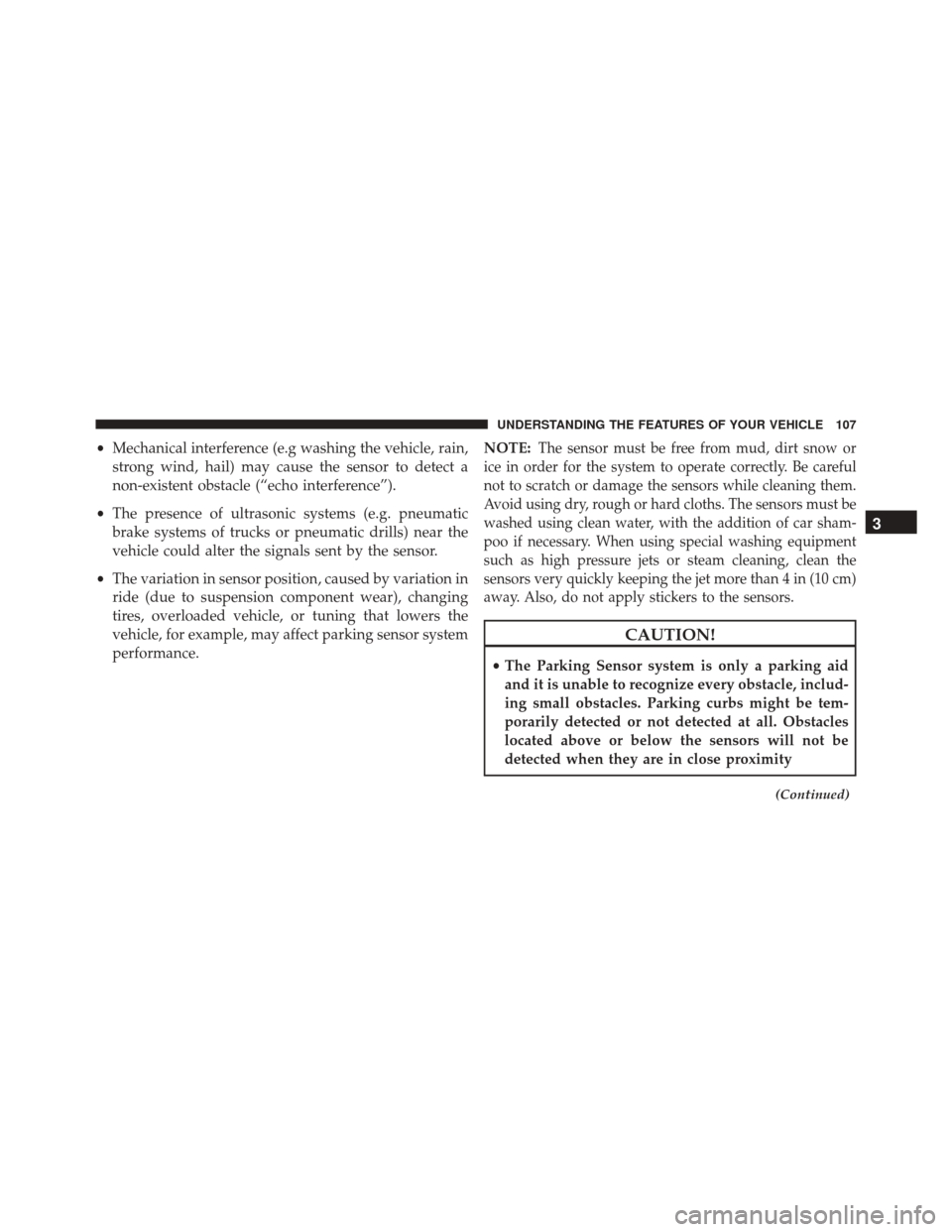
•Mechanical interference (e.g washing the vehicle, rain,
strong wind, hail) may cause the sensor to detect a
non-existent obstacle (“echo interference”).
• The presence of ultrasonic systems (e.g. pneumatic
brake systems of trucks or pneumatic drills) near the
vehicle could alter the signals sent by the sensor.
• The variation in sensor position, caused by variation in
ride (due to suspension component wear), changing
tires, overloaded vehicle, or tuning that lowers the
vehicle, for example, may affect parking sensor system
performance. NOTE:The sensor must be free from mud, dirt snow or
ice in order for the system to operate correctly. Be careful
not to scratch or damage the sensors while cleaning them.
Avoid using dry, rough or hard cloths. The sensors must be
washed using clean water, with the addition of car sham-
poo if necessary. When using special washing equipment
such as high pressure jets or steam cleaning, clean the
sensors very quickly keeping the jet more than 4 in (10 cm)
away. Also, do not apply stickers to the sensors.
CAUTION!
• The Parking Sensor system is only a parking aid
and it is unable to recognize every obstacle, includ-
ing small obstacles. Parking curbs might be tem-
porarily detected or not detected at all. Obstacles
located above or below the sensors will not be
detected when they are in close proximity
(Continued)
3
UNDERSTANDING THE FEATURES OF YOUR VEHICLE 107
Page 110 of 371
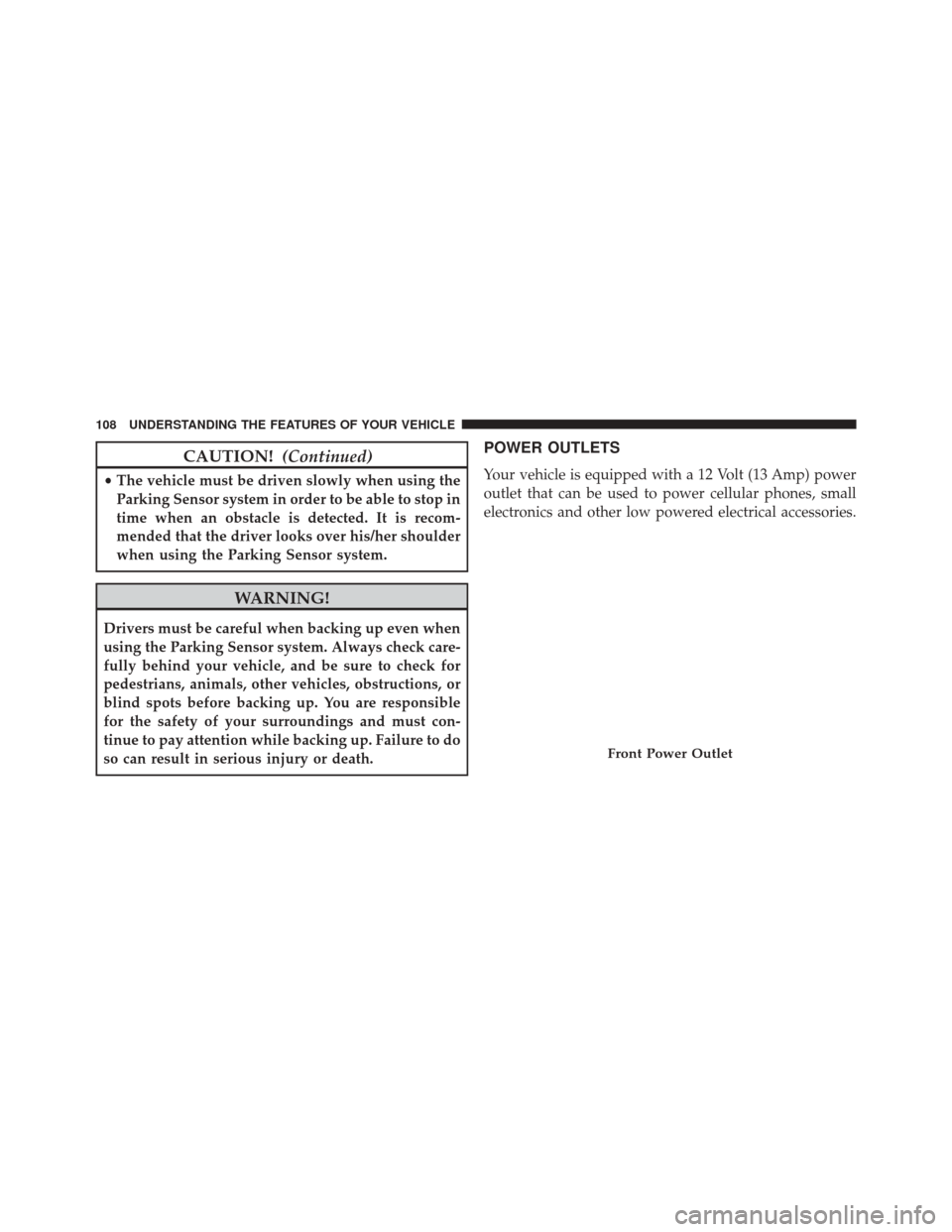
CAUTION!(Continued)
•The vehicle must be driven slowly when using the
Parking Sensor system in order to be able to stop in
time when an obstacle is detected. It is recom-
mended that the driver looks over his/her shoulder
when using the Parking Sensor system.
WARNING!
Drivers must be careful when backing up even when
using the Parking Sensor system. Always check care-
fully behind your vehicle, and be sure to check for
pedestrians, animals, other vehicles, obstructions, or
blind spots before backing up. You are responsible
for the safety of your surroundings and must con-
tinue to pay attention while backing up. Failure to do
so can result in serious injury or death.
POWER OUTLETS
Your vehicle is equipped with a 12 Volt (13 Amp) power
outlet that can be used to power cellular phones, small
electronics and other low powered electrical accessories.
Front Power Outlet
108 UNDERSTANDING THE FEATURES OF YOUR VEHICLE